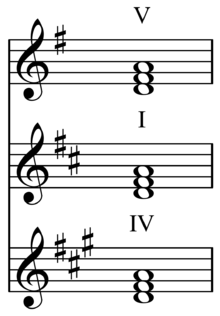Common chord (music)
This can be easily determined by a chart similar to the one below, which compares chord qualities.When analyzing a piece that uses this style of modulation, the common chord is labeled with its function in both the original and the destination keys, as it can be seen either way.The number of diatonically occurring chords that two keys share is a measure of how closely related they are.A closely related key can be defined as one that has many common chords.Less closely related keys have two or fewer chords in common.
diatonictriadicmodulationsclosely related keychord qualitiesroot notepredominant chordsfunctionrelative major or minordominantsubdominantEnharmonic scaleCommon tone (chord)Common tone (scale)Oxford English DictionaryOxford University PressStanley SadieJohn TyrrellChordsAugmentedDiminishedSuspendedSeventhDominant seventh flat fiveHalf-diminishedDiminished majorMinor-majorAugmented majorAugmented minorAltered seventhNondominantHarmonic seventhExtendedEleventhThirteenthUpper structureDominant 7♯9PolychordTone clusterAugmented sixthLydianSeven sixBridgeComplexe sonoreElektraFarbenMysticNorthern lightsPetrushkaPsalmsSo WhatTristanViennese trichordMixed intervalSecundalTertianQuartalSynthetic chordTetradSupertonicMediantSubmediantLeading toneSubtonicAlteredApproachBorrowedChromatic mediantNeapolitanPassingSecondarySecondary dominantSecondary leading-toneSecondary supertonicContrastPrimary triadSubsidiarySubstituteChordioidChord-scale systemGuitarArpeggioChord names and symbolsList of chordsFactor